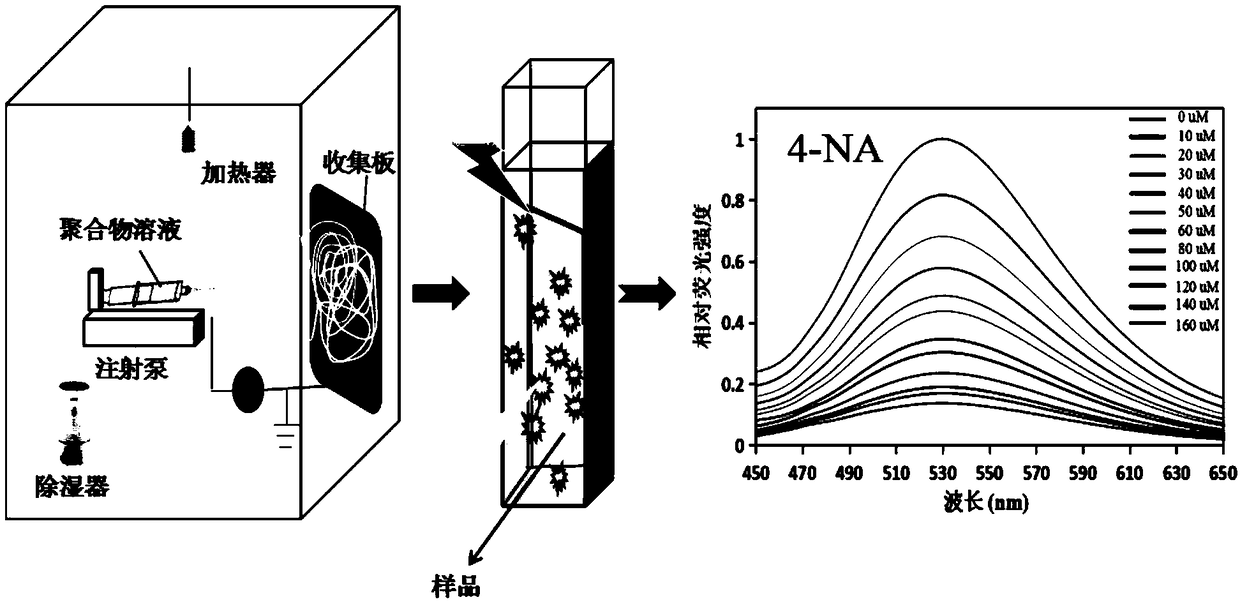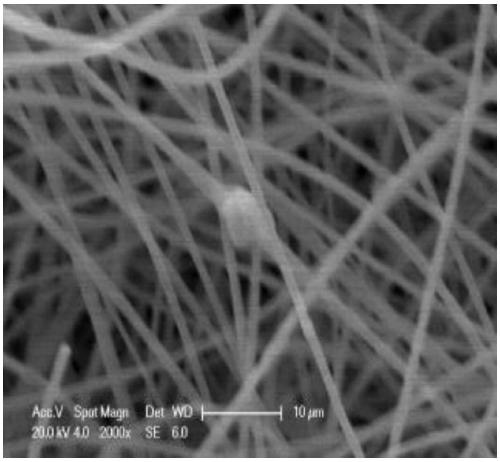Preparation method and application of fluorescent nanofiber film based on bimetallic organic framework
A technology of fluorescent nanofibers and organic frameworks, which is applied in the field of preparation of fluorescent nanofiber membranes, can solve the problems of separation and recycling of difficult MOF powders and analyte solutions, time-consuming, etc., and achieve multiple repeatable detection and good selectivity , to achieve the effect of economic applicability
- Summary
- Abstract
- Description
- Claims
- Application Information
AI Technical Summary
Problems solved by technology
Method used
Image
Examples
Embodiment 1
[0038] Preparation of Fluorescent Nanofiber Membrane
[0039] The preparation method is as follows:
[0040] Step 1: Preparation of bimetallic organic framework
[0041] 51mg 4,4', 4", 4"'-(ethylene-1,1,2,2-tetrayl)tetrakis-([1,1'-biphenyl]-4-carboxylic acid) was added to 30mL DMF : EtOH (v / v, 1:2) in the autoclave, sonicated for 5 minutes to dissolve it. Add ZrCl 4 (120mg, 0.52mmol) and ZnCl 2 (70mg, 0.52mmol) into the autoclave. Then, the autoclave was placed at 120°C for 48 hours. After the reaction, the autoclave was taken out and cooled to room temperature. The product was washed three times with DMF:EtOH (v / v, 1:2), and dried under vacuum at 60°C overnight. That is, a bimetallic organic framework is obtained.
[0042] Step 2: Prepare electrospinning solution
[0043] Disperse the BiMOF (4mg) into 3mL DMF:CHCl 3 (v / v: 1:1), sonicate for 30 minutes. Then, 0.92g PMMA was added in the above-mentioned mixture solution and magnetically stirred for 12 hours, and the so...
Embodiment 2
[0046] Fluorescence Nanofiber Membrane Performance Test
[0047] Morphology analysis: The morphology of the fiber membrane was observed using a scanning electron microscope (SEM). figure 2 The scanning results are shown, and it can be seen from the figure that the nanofibers have a smooth shape, and the diameter is about 0.7-1.6um.
[0048] Optical performance characterization: The optical performance of the fluorescent nanofiber membrane was characterized by a fluorescence spectrophotometer. image 3 The characterization results are shown: the excitation wavelength of the fluorescent nanofiber film is 373 nm, and the emission wavelength is 530 nm.
Embodiment 3
[0050] Sensitivity test of fluorescent nanofibrous membranes to TNP, 4-NA, NFT and NFZ
[0051] testing method:
[0052] (1) The fluorescent nanofiber membrane is placed in aqueous solutions containing different concentrations of TNP, 4-NA, NFT and NFZ for detection;
[0053] (2) Fluorescent nanofiber membranes were placed in TNP, 4-NA, NFT and NFZ aqueous solutions containing 0, 10, 20, 30, 40, 50, 60, 80, 100, 120, 140, 160uM for fluorescence testing ;
[0054] (3) The quenching effect of TNP, 4-NA, NFT and NFZ on the fluorescent nanofiber membrane was explained by the Stern-Volmer equation, and the Stern-Volmer constant was obtained.
[0055] Result analysis:
[0056] Figure 4 The fluorescence emission spectra of fluorescent nanofiber membranes with the concentration of quencher are given. It can be seen from the figure that as the concentration of the quencher increases, the fluorescence intensity decreases gradually, and the detection limits for TNP, 4-NA, NFT and N...
PUM
| Property | Measurement | Unit |
|---|---|---|
| wavelength | aaaaa | aaaaa |
| emission peak | aaaaa | aaaaa |
Abstract
Description
Claims
Application Information
 Login to View More
Login to View More - R&D
- Intellectual Property
- Life Sciences
- Materials
- Tech Scout
- Unparalleled Data Quality
- Higher Quality Content
- 60% Fewer Hallucinations
Browse by: Latest US Patents, China's latest patents, Technical Efficacy Thesaurus, Application Domain, Technology Topic, Popular Technical Reports.
© 2025 PatSnap. All rights reserved.Legal|Privacy policy|Modern Slavery Act Transparency Statement|Sitemap|About US| Contact US: help@patsnap.com



